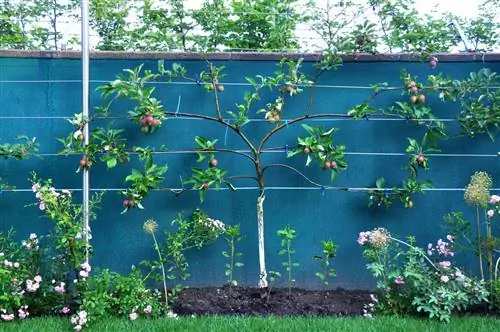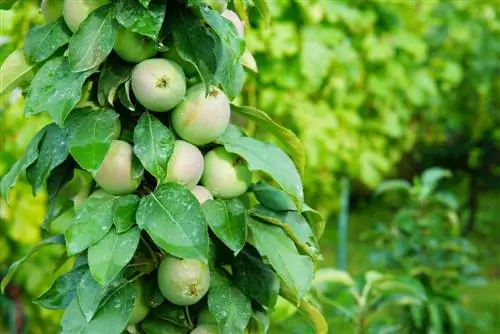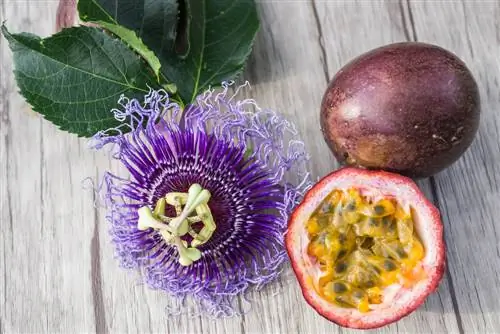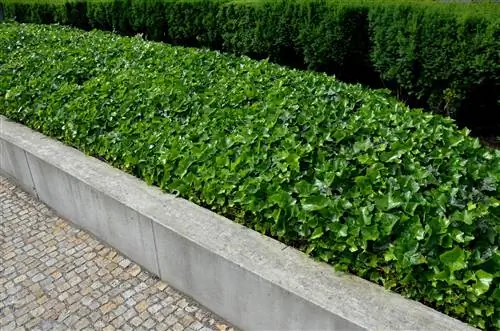- Author admin [email protected].
- Public 2024-01-07 16:36.
- Last modified 2025-01-23 11:22.
In order to minimize the risk of disease and pest infestation on columnar fruit, underplanting can be very beneficial. It also keeps away weeds and attracts pollinating insects. Below you will find out which plants are suitable for this.
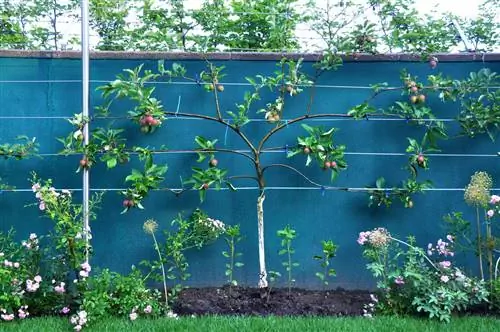
Which plants are suitable for underplanting columnar fruit?
For underplanting columnar fruit,partum shade-tolerant, shallow-rootedandsmaller herbs, summer flowers, early bloomers, leeks and berries are suitable. Particularly recommended are:
- Malissa or peppermint
- Marigolds or nasturtiums
- Lily of the valley or cowslips
- Garlic or chives
- Strawberries or currants
Planting columnar fruit with herbs
Since the narrow growth habit of the columnar fruit allowsplenty of lightto reach the ground, some herbs feel extremely comfortable at the foot of the tree. Some of them have the ability to strengthen thepillar fruit The essential oils contained in herbs help with this. They can deter pests such as aphids and also make it difficult for many diseases. The following are ideal for underplanting columnar fruit:
- Melissa
- Peppermint
- Lavender
- Mountain Savory
Planting columnar fruit with summer flowers
Summer flowers candiseaseson columnar fruitpreventand attractbeneficial insects. For example, nasturtium, as a ground-covering summer flowering plant, can help against apple leaf suckers and also prevent weeds. Marigolds and columbine attract bees, which help with pollination, and red foxglove prevents gum flow. The following summer flowers are recommended for underplanting:
- Nasturtium,
- Storksbill,
- Marigolds,
- Columbine,
- Dahlias,
- Red Foxglove or
- Phacelia.
Planting columnar fruit with early bloomers
Early bloomers bloom at about the same time as the columnar fruit. They attractbeesalmost magically. This increases the probability and the rate that the flowers will be pollinated by thepillar fruit.
It is best to plant early bloomers under your columnar fruit that bloom at the same time, such as columnar cherry with lily of the valley, pear and apple with daffodils, plum, peach and mirabelle plum with cowslips. Here is a selection of suitable early bloomers for underplanting:
- Lily of the valley
- Primrose
- Lungwort
- Daffodils
- Tulips
- Crocuses
Planting columnar fruit with berries
Is the columnar fruit in the kitchen garden and do you love berries? Then you have the option of planting berries under the columnar fruit. However, pay attention to therootworkof the respective columnar fruit. Apple, cherry, peach and plum have shallow roots, while pears have deeper roots. The shallow-rooted plants should be carefully planted with berries, ideally in thefirst year of growthand at a distancedistancefrom thetree slice How about these delicious berries at the foot of the pillar fruit?
- Strawberries
- Redcurrants
- Blackcurrants
- Gooseberries
- Wild strawberries
Planting columnar fruit with allium plants
Allium plants are known to be extremelyinsectsandVolesextremelyunpopularto be. This also applies toPathogens Garlic and chives can work against scab and onions keep voles away. Here is a list of the most effective leek plants for underplanting:
- garlic
- Chives
- Wild garlic
- Allium
- Onions
Planting columnar fruit in the pot
If you cultivate the columnar fruit in a bucket, you can plant it with flowering and undemanding plants to cover the baresoilandoptical charmsto accomplish. Compatible with columnar fruit include:
- Hardworking Lieschen
- Ice Begonias
- Storksbill
- Hanging Petunias
Tip
Leave double early bloomers for underplanting
Double daffodils and tulips are almost worthless for underplanting. Bees do not find nectar in these varieties and are therefore not attracted to them. It is therefore advisable to only plant unfilled early bloomers under the columnar fruit.

